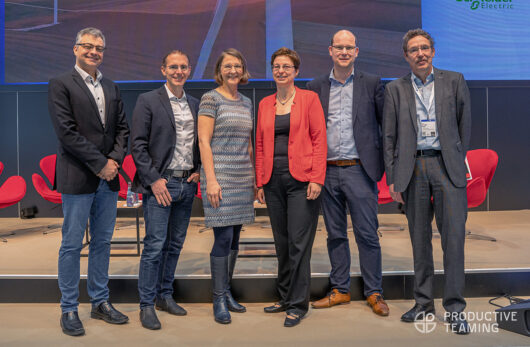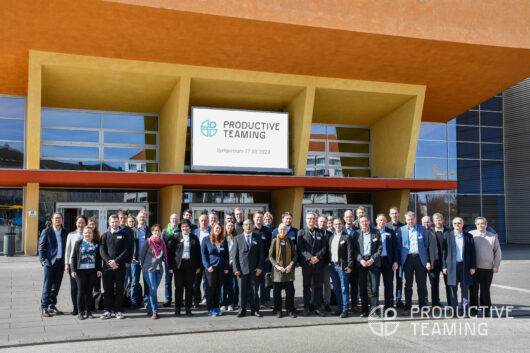Faced with rapid technological advancements, the forward-looking vision of the research initiative is to elevate the collaboration between humans and machines to a new level. The goal is to enable a new generation of dynamic human-machine teams in production systems capable of handling more complex and adaptive challenges than current cyber-physical systems or human teams.
Instead of traditional production automation that heavily relies on fixed, predetermined processes, Teaming Production Systems aim to focus on maintaining flexibility and adaptability of production processes. This involves implementing human innate abilities for agile responses and adaptation to disruptions, such as errors from previous process steps or required input quantities for semi-finished products, also on a machine level. Rather than aiming for maximum automation and the associated need for standardizing production processes, the “Productive Teaming” research initiative seeks to enable maximum flexibility and dynamism in production, both in terms of individual production steps and the design of the finished product (batch size 1). This paradigm shift promotes the emergence of adaptive manufacturing processes, improvement of working conditions, greater sustainability, and stronger product individualization, addressing the challenges of Industry 5.0.
To achieve these goals, intelligent systems should be improved to i) draw conclusions at a cognitive level, ii) coordinate interdependent actions for seamless, goal-directed, and coherent teamwork, iii) design shared action plans, and iv) create trust and acceptance through transparency in decision-making. The resulting new stage of human-machine symbiosis leads to more flexibility in the production landscape, reduced material and energy consumption, and a general reduction in cognitive and physical burdens for human workers.
“Productive Teaming” is a collaborative research initiative of TU Chemnitz, TU Ilmenau, and OVGU Magdeburg. The three universities complement each other excellently in the network, which is dedicated to human-technology interaction and is expected to expand into other research areas in the future. Each of the three universities brings its specific expertise – TU Chemnitz in the field of “Human-Machine Interaction and Cognitive Systems,” TU Ilmenau in the area of “Intelligent Sensing and Complex Systems,” and OVGU Magdeburg in the research field of “Artificial Intelligence and Digital Engineering.”
Participations:
Technische Universität Chemnitz
Prof. Dr. Dr. Marco Ragni
Reichenhainer Str 41, 09126 Chemnitz
Phone: +49 371 531-38284
Email: marco.ragni@metech.tu-chemnitz.de
Technische Universität Ilmenau
Prof. Dr. Gunther Notni
Gustav-Kirchhoff-Platz 2, 98693 Ilmenau
Phone: +49 3677 69-3820
Email: gunther.notni@tu-ilmenau.de
Otto-von-Guericke-Universität Magdeburg
Prof. Dr. Frank Ortmeier
Universitätsplatz 2, 39106 Magdeburg
Phone: +49 391-67-52804
Email: frank.ortmeier@ovgu.de
Duration: since 2022
Events
Chemnitz University of Technology is planning a digital lecture series in cooperation with the CHIM research and innovation network from mid-September 2023. Initially, 10 dates are planned every 14 days, during which experts will share and discuss their knowledge and experience as well as current research results and trends in the field of “Productive Teaming” with interested scientists from the three locations. Further information on the dates and registration will be announced shortly.
How can humans and machines collaborate as a team? On April 21, scientists from TU Chemnitz, OVGU Magdeburg, TU Ilmenau, Fraunhofer IFF, and the Digital Agency Saxony discussed these and other questions about “Productive Teaming” at the Hannover Messe 2023. (Click here for the news article)

The tri-university research initiative “Productive Teaming” brought together over 40 scientists from various institutions to discuss and explore collaboration opportunities on the topic of “Teaming between human and artificial agents” and to develop solutions for productivity enhancement. (Here is the link to the news article)
